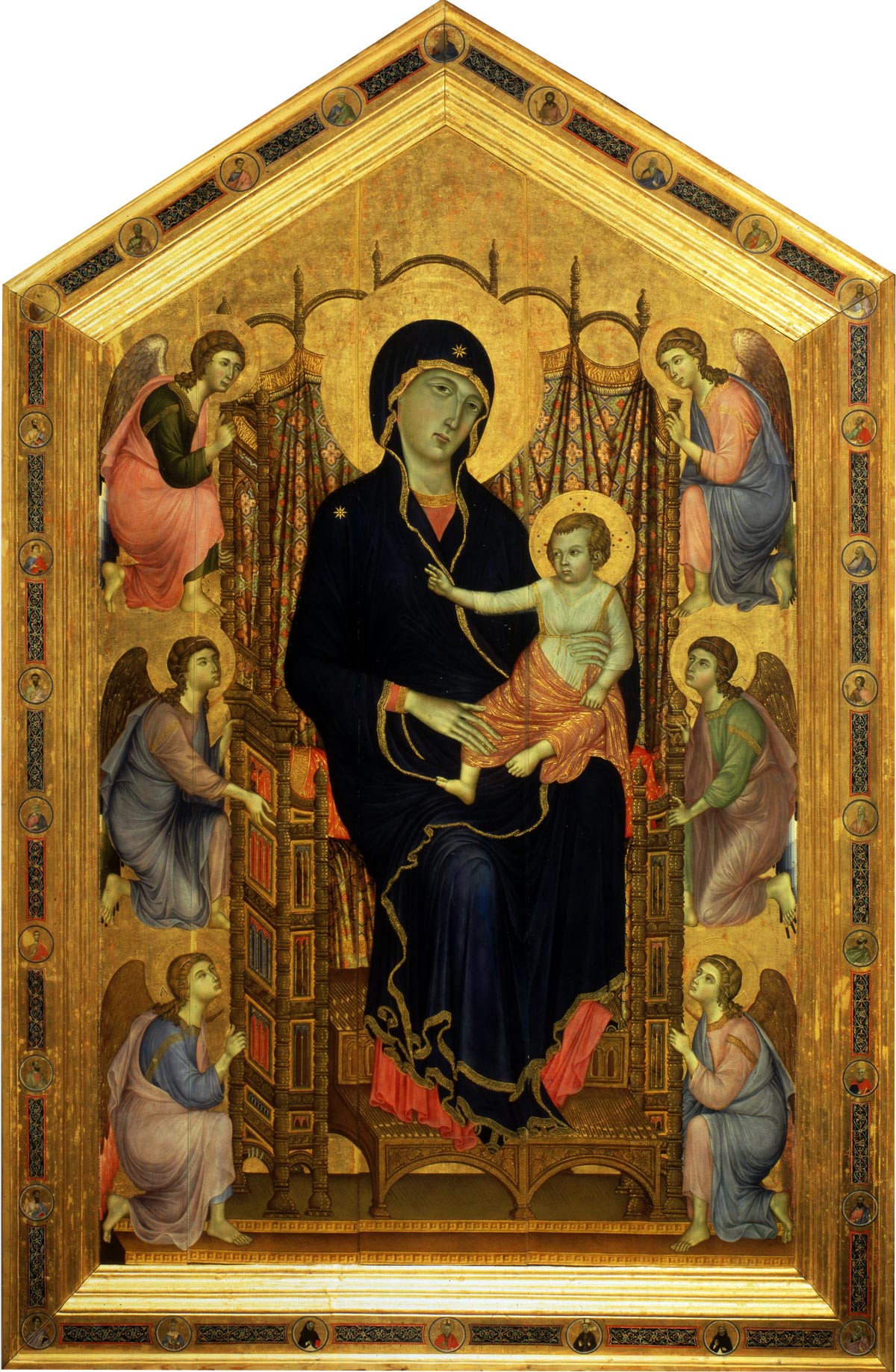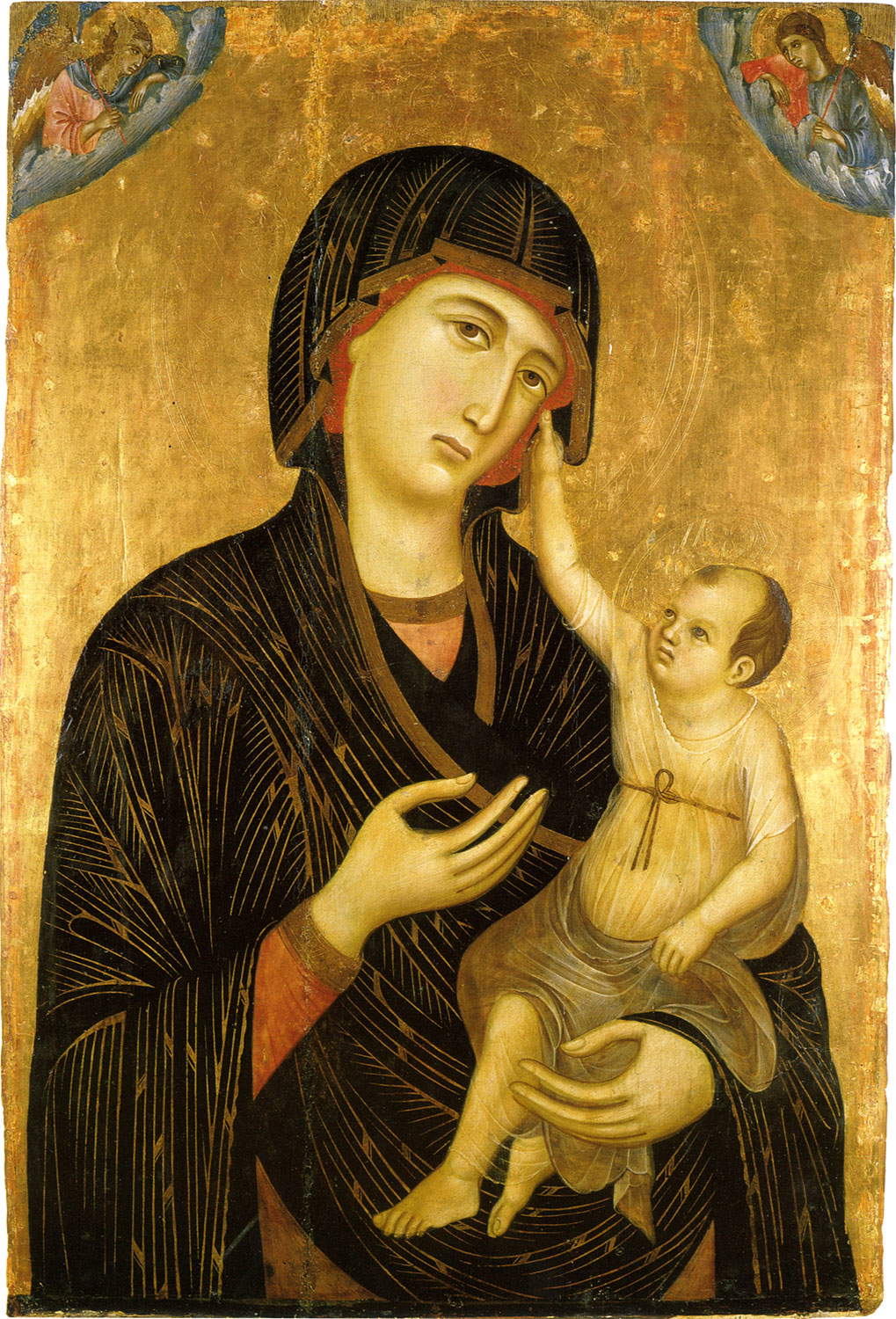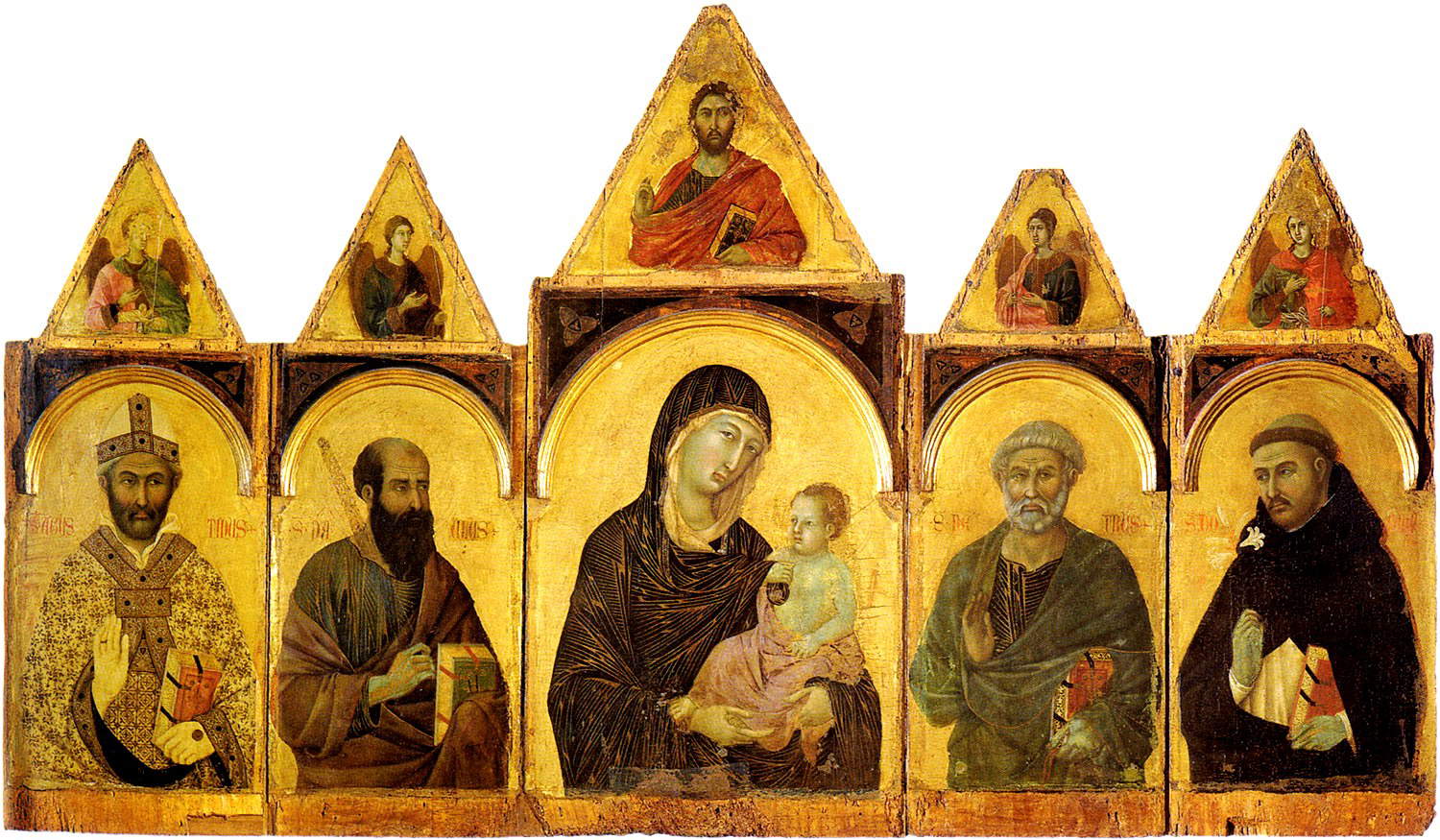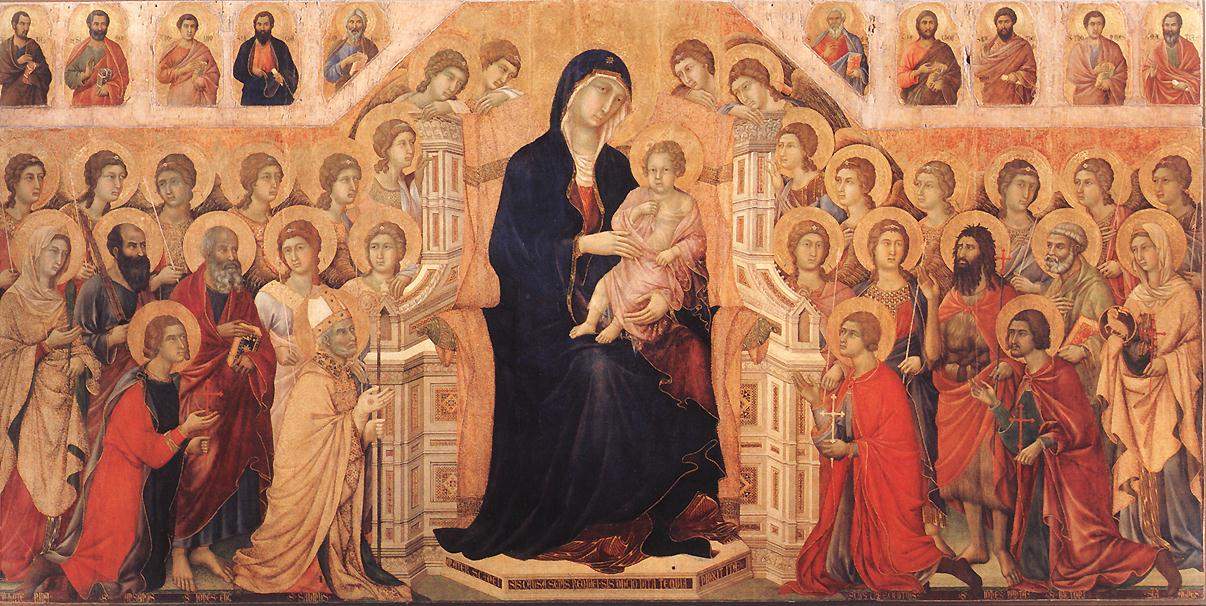Duccio di Buoninsegna (Siena, c. 1255 - 1318) is one of the most significant and influential painters in the history of Italian art. We do not have much information about him, but his art was indispensable for the artists of later generations. Duccio, considered the father of the Sienese school, formed himself in the wake of the tradition of his hometown, Siena, which was still based on a Byzantine style, and brought it up to date with the achievements of Cimabue (the two were often so close that in the past many of Duccio’s works were attributed to Cimabue) and the innovations of the French Gothic: in particular, Duccio gave the Sienese school the refined and elegant taste that, from him onward, would be one of the defining characteristics of the works produced in Siena. Not many works remain to us by Duccio di Buoninsegna, and his masterpieces are mostly preserved in Tuscany.
All subsequent Sienese painting, from Simone Martini to the brothers Pietro and Ambrogio Lorenzetti (who were perhaps his pupils) had in Duccio the main point of reference: at the time, Siena was contending with Florence for the primacy of art, and consequently Duccio was one of the main points of reference of his time. At the time he was working, Siena was a very powerful city, able to rely on a flourishing economy, and its political stability had contributed greatly to this, thanks in part to a municipal structure that allowed all the social classes of the city to participate in the administration of public affairs. In 1260, with the Battle of Montaperti, Siena came to a direct clash with Florence: the battle was won by the Sienese, but they were in turn defeated nine years later at Colle di val d’Elsa. These clashes also had consequences on a cultural level, since there were also artistic exchanges between the Sienese and the Florentines: for example, in 1261 the Florentine Coppo di Marcovaldo, probably the most modern and up-to-date artist of the time from the Florentine area, arrived in Siena as a prisoner following the battle of Montaperti, and this presence brought a wave of renewal to the local school, which for the first time opened up to the volumetries of the Florentines. In fact, the Sienese school had until then remained substantially tied to the Byzantine tradition, and the arrival of Coppo di Marcovaldo helped to bring it up to date.
With Duccio, the Sienese school, which already boasted a certain tradition anyway (think, for example, of the figure of Guido da Siena, knew its first major exponent. Duccio’s education is very problematic because news about the early years of his life is few and very sketchy, so it is very difficult to reconstruct his artistic career in the early stages. The earliest news about him dates back to 1278, when Duccio was already an independent painter, so we have no documents about his training and can only speculate on the basis of the paintings we know. And on his training not all critics agree: given Duccio’s innate elegance, many believe that he was based on the local Byzantine tradition, but some have also considered him a pupil of Cimabue, given his closeness to the Florentine artist. Then there are those who lean toward considering him a pupil of Guido da Siena mentioned earlier, an artist already touched, in his maturity anyway, by Cimabuesque innovations. However, there is no certain evidence. In addition, a painter active in Assisi, known as the Maestro Oltremontano, perhaps also played a role on his training: he came from France and helped to spread French figurative culture in Umbria as well (some scholars in fact speculate on a youthful presence of Duccio in Assisi, where he would have assisted Cimabue and where he would therefore have also observed the art of the Maestro Oltremontano).
 |
| Duccio di Buoninsegna, Madonna and Child Enthroned with Angels, known as Madonna Rucellai (1285; tempera on panel and gold ground, 450 x 290 cm; Florence, Uffizi Gallery, on deposit from the church of Santa Maria Novella in Florence, City of Florence) |
Duccio di Buoninsegna was born in Siena, probably around 1255: since no documents remain on the early years of his life, the date of his birth is assumed on the basis of later news. The family is of Lucca origin (Duccio’s grandfather was born in Lucca). The artist is first mentioned in 1278 in a payment he received from the City of Siena for painting document chests. In contrast, another document dates from 1279 that acknowledges him a payment for illuminating the covers of two books. In 1280, Duccio received a fine for an offense, the details of which we do not know, and it was the first of a long series: this has led scholars to speculate that Duccio lived a decidedly unregulated life. In 1285, the artist is in Florence, where on April 15 he makes an agreement with the local Società delle Laudi to paint a large panel: it is the celebrated Madonna Rucellai (now in the Uffizi Gallery), his first definitely documented and therefore datable work.
In 1286 Duccio was again paid by the City of Siena to decorate books, an activity that he would continue for at least another decade, while in 1295 he was part of a commission that had to choose the site where the Fonte d’Ovile, an important reservoir located at the gates of Siena and that was to supply the city with water, was to be placed. From 1296, for some years, he was absent from Siena, but we do not know where he went: there are those who speculate that during this time he may have gone to Paris, although there is no certainty about this (for many it is in fact an entirely implausible hypothesis). In any case, in 1302 Duccio figures again in Siena, where he would remain for the rest of his life. In addition to still receiving several administrative penalties, in the same year he is paid for a Majesty, which, however, did not reach us. In 1308 Jacopo de’ Marescotti, Operaio del Duomo di Siena, commissioned from him what is probably considered Duccio’s greatest masterpiece, the Maestà for the Duomo now in the Museo dell’Opera del Duomo in Siena. Duccio finished the Maestà in 1311: on June 9 of that year, a solemn procession accompanied it to the high altar of the Duomo. Duccio was also active in the last years of his life: some scholars attribute to him the fresco with the Consegna del castello di Giuncarico, discovered in the 1980s in the Sala del Mappamondo in Siena’s Palazzo Pubblico and datable to 1314, while in 1316 he painted the splendid Maestà in the Duomo of Massa Marittima. The artist disappeared in Siena probably in 1318: in 1319, in fact, his sons refused his inheritance, as Duccio was heavily in debt.
 |
| Duccio di Buoninsegna, Madonna di Crevole (1283-1284; tempera and gold on panel, 89 x 60 cm; Siena, Museo dell’Opera del Duomo) |
 |
| Duccio di Buoninsegna, Madonna and Child (c. 1300-1308; tempera and gold on panel, 97 x 63 cm; Perugia, National Gallery of Umbria) |
 |
| Duccio di Buoninsegna, Polyptych 28 (c. 1300-1308; tempera and gold on panel, 138.6 x 241.5 cm; Siena, Pinacoteca Nazionale) |
 |
| Duccio di Buoninsegna, Maestà, recto (1308-1311; tempera on panel, 214 x 412 cm; Siena, Museo dell’Opera del Duomo) |
Duccio’s earliest work that can be dated with certainty is the Madonna Rucellai, which is also the largest painted panel of the 13th century that has come down to us(read a lengthy and detailed discussion of the work here). For centuries, the Rucellai Madonna was believed to be the work of Cimabue: this is because this is how the oldest sources, dating back to the 14th century, remember it, and on the basis of these sources even Giorgio Vasari himself in his Lives attributed the painting to Cimabue, considering it one of his best works. Clearing the field of misunderstandings came the discovery of the document attesting to the painting’s commission: according to that document, the work was commissioned from Duccio di Buoninsegna on April 15, 1285 by a confraternity, the “Society of the Virgin” or “Society of the Laudi,” also called the “Company of the Laudesi,” which is why the work is also known as the Laudesi Altarpiece. Today we know it as Madonna Rucellai because in the 17th century it was moved to the aristocratic chapel of the Rucellai, one of the most important Florentine families of the time. The work makes clear the problems about the relationship between Duccio and Cimabue: from the Florentine master, Duccio takes some elements such as the Madonna’s pose, that of the Child Jesus, and the expedient of the angels being placed around the throne. However, it is also necessary to note the profound differences that appear between Duccio’s works and those of Cimabue (for example, in the Majesty preserved in the Louvre), starting with the angels themselves: in Cimabue they appeared on different planes, superimposed on each other, as if those at the top were above a ladder. In Duccio, on the other hand, they are symmetrically arranged two by two and are all kneeling, making the whole appear much more abstract than in Cimabue, precisely because they are flying and do not seem to be leaning anywhere, and especially the colors of the robes become much gentler and more delicate than in Cimabue. Again, it is possible to note that the proportions of the Madonna are more elongated in the upper part of the body, and more uncertain in the legs than in Cimabue. There is thus a different conception of spatiality: Duccio’s intent is to create a composition that is more symbolic than verisimilar, a legacy of the Byzantine tradition. The element of great novelty, however, is the introduction of innovations derived from French Gothic into Tuscan figurative culture: these elements will be the ones that, more than others, will contribute to giving Sienese painting the sense of refinement and elegance that constitutes its distinctive trait. Duccio was the first of these artists: we notice these details, in the Rucellai Madonna, both in the cloth that decorates the throne, which bears a refined floral decoration in the Gothic style, and in the golden border of the Virgin’s mantle, which creates this somewhat unreal and arty but very refined motif.
Other works that can help suggest a path throughDuccio di Buoninsegna’s art include the various Madonnas, starting with the Madonna di Crevole, so called because for a certain period of time it was in the church of Santa Cecilia in Crevole, near Siena, although it was previously in the hermitage of Montespecchio. The work has been related to a painting by Cimabue, the Madonna of Castelfiorentino, which is in the Museum of Santa Verdiana in Castelfiorentino(more on the work here): Duccio’s work, however, is characterized by a greater humanity, which shines through not only in the flesh tones that appear more tender than those observed in Cimabue’s painting, but especially in the expressions of the two characters (one appreciates a greater gentleness, a greater affection in the gazes of the protagonists and also in their mouths, although the whole can still make the composition appear as a Byzantine icon, and to the Byzantine tradition refer in fact also the two angels that can be seen in the upper corners of the panel). Even the draperies, with the chrysographies (i.e., the golden streaks that furrow the garment) that are typically Byzantine (and in any case also present in Cimabue), take on a more sinuous and elegant course than in Cimabue’s Madonna. And even the Child’s pose of the rest in Duccio appears more composed and elegant.
Another masterpiece of refinement is the Madonna and Child in the Galleria Nazionale dell’Umbria Perugia, which introduces a new motif in Duccio’s art: the Madonna in fact wears a white veil on her head just below her robe, and we can see that the Child, with a very tender gesture of surprising naturalness, brings this veil toward himself, as if he wants to play with it. With this Madonna, Duccio makes a further attempt in the process of humanizing the figures with respect: the hands of the Madonna and the Child touch each other, and this touching (despite the still traditional shape of the hands) is a detail that introduces a dimension of humanity never before touched by Duccio, which is added here to the always very delicate expressions of the characters. The chiaroscuro of the flesh tones also becomes more natural, thus testifying to an evolution in Duccio’s painting that has led scholars to date the painting around 1300. However, there are also those who see in this Madonna a concession to Giotto’s volumetries, and thus there are also scholars who move the work to a later period in Duccio’s career, around 1308, a time when Giotto ’s art had already begun to spread. Around the same time dates the so-called Polyptych 28, so called because it is recorded as number 28 in the catalog of the Pinacoteca Nazionale di Siena where it is preserved. The polyptych, one of the oldest in Italian painting (we do not know, however, whether it is the oldest ever), consists of five compartments: in the center is the Madonna and Child and on the sides, in order from the left, Saints Augustine, Paul, Peter and Dominic. The Madonna, in the center, bears remarkable similarities to the Perugian Madonna: the Madonna’s head is covered by the veil, and the Child makes the same gesture as on the Perugia panel, although here he does not play with the veil but directly with his mother’s robe. The hands do not touch each other but, Jesus’ feet rest directly on the Madonna’s hands (the right one seems almost to move naturally and curiously), and the Child’s expression is almost identical to that of the Child in the Madonna of the National Gallery of Umbria. It is therefore safe to assume that the works were produced at the same time.
Finally, the Maestà of the Opera del Duomo in Siena is the work that perhaps sums up the whole evolution of Duccio di Buoninsegna’s art and constitutes its highest point, as well as being the best documented work, painted between 1308 and 1311. Today the Maestà, which is of imposing dimensions because it is more than two meters high and more than four meters wide, is no longer in the Duomo but is kept not far away, at the Museo dell’Opera del Duomo, where it was transferred in 1878. The work depicts the Madonna and Child Enthroned (the Madonna was considered the patron saint of Siena) and is painted on both the recto and verso, that is, on both the front and back sides, and on the back side is a series of compartments telling the stories of Christ. Some parts have unfortunately been lost: for example, the predella, which told stories of Christ’s infancy, and some of the compartments at the top (the work was wretchedly dismembered in 1771 and many parts, besides the frames, were lost). The stories on the back side are all contained in compartments of equal size, except for the two central ones, which are a larger, and an almost geometric order can also be seen on the main side: next to the Madonna, who occupies vertically the entire center of the composition, the saints are arranged in three parallel and symmetrical planes, and they are all the same height. This order has a function, which is to lend majesty and solemnity to the composition. We find in the Majesty all the characteristics that made Duccio’s art great: the faces of the saints are very delicate (particularly those of the female figures), we notice symmetry, a great profusion of gold, in the background and in the aureoles (gold refers to the light of God, so it has a symbolic function), a marked taste for elegance that is evident from many details, beginning with the Virgin’s gold-edged mantle with its sinuous lines and the decorations of the clothing of certain saints, such as that of Saint Savinus, the saint kneeling at the very foot of the throne. The four saints in the foreground have a well-defined role in that they are the four patron saints of Siena: saint Ansanus, saint Savinus, saint Crescentius, and saint Victor. The Madonna of Duccio’s Majesty, which obviously still has an iconography of Byzantine derivation and is still imbued with the refinement that came to our artist from his proximity to French models, begins to open itself up to Giottesque novelties that had already been evident for some years, for example in the Madonna of Perugia. These novelties include, for example, the throne (of cosmatesque taste and covered with an ornate cloth), which is no longer placed in tralice, three-quarter view, but is rendered with an intuitive frontal perspective, which thus makes it far more verisimilar than the thrones that Duccio had previously depicted. This expedient then lends a greater monumentality to the figure of the Madonna, which further enhances the sense of solemnity emanating from this splendid Majesty. From Giotto then comes a new sensitivity to chiaroscuro and the calibration of light: everything appears much more reasoned and naturalistic than Duccio had done in the past. Thus we see an interesting mixture of Giottesque elements and elements of the Sienese school: this is the first work by Duccio in which this phenomenon is observed, and the few subsequent works will continue along this path. But it is with Duccio di Buoninsegna’s Maestà that the great Sienese Trecento opens.
To discover Duccio’s art, a visit to Siena is a must: in the city you can visit the Museo dell’Opera del Duomo where there are two undisputed masterpieces, one from his maturity (the Maestà) and one from his youth (the Madonna di Crevole), as well as the Pinacoteca Nazionale. Also in the city of his birth, a visit to the Palazzo Pubblico is not to be missed to admire the Consegna del castello di Giuncarico, a 1314 fresco given by many scholars to Duccio.
Near Siena, the Val d’Arbia Museum of Sacred Art in Buonconvento houses the Madonna and Child known as the “Madonna di Buonconvento.” In Florence, the Rucellai Madonna can be seen at the Uffizi, while remnants of Duccio’s frescoes can be found in the Basilica of Santa Maria Novella (for which the Rucellai Madonna was moreover intended). In Turin, the Galleria Sabauda preserves another early masterpiece, the Gualino Madonna. In Perugia, the National Gallery of Umbria preserves the Madonna and Child also known as the “Madonna of Perugia.” Finally, among Duccio’s rare certain works, you can see the Massa Marittima Majesty in the Cathedral of the Maremma town.
 |
| Duccio di Buoninsegna: life, works and masterpieces of the great Sienese painter |
Warning: the translation into English of the original Italian article was created using automatic tools. We undertake to review all articles, but we do not guarantee the total absence of inaccuracies in the translation due to the program. You can find the original by clicking on the ITA button. If you find any mistake,please contact us.